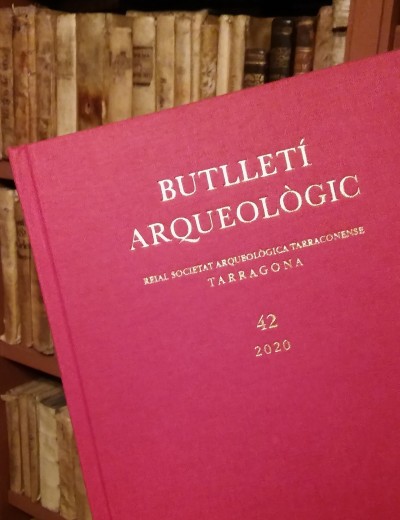
Following its annual commitment, the Reial Societat Arqueològica Tarraconense (RSAT) has just published the latest issue of the journal Butlletí Arqueològic (2020). This scientific journal has a history of more than one hundred years, being the oldest in Catalonia in its genre. It is published with the sponsorship of Fundació Privada Mútua Catalana, the Tarragona City Council and the Tarragona Provincial Council.
Current issue of the journal has the participation of the ICAC researchers Joan Canela, Jordi López Vilar, Josep Francesc Roig, Joaquín Ruiz de Arbulo, Julio C. Ruiz y Patricia Terrado.
It is a 284-page hardcover, cloth-bound volume that is richly illustrated. It includes a dozen articles written by 19 researchers who belong to different institutions in Tarragona, Barcelona, Saragossa and Rome, written basically in Catalan, but also in Spanish and Italian.
The book opens with a paper on the Protohistoric town of Alt Camp (Tarragona), based on archaeological works carried out by ICAC visiting researcher Joan Canela and Núria Otero in the years 2012-2014.
Then follows a block with different issues about Roman Tarraco. Antonio Mostalac and Carmen Guiral talk about the Roman mural painting found in the archaeological works in the Tarragona Port 19th century quarry; Antonio Peña renews the debate on the decoration of the portico of the acropolis cult temple; and Julio C. Ruiz, ICAC PhD researcher, writes about epigraphy as a topographic source, focusing on inscriptions on buildings and sacred spaces of a public nature. This Tarraco section ends with a collective article that presents new fragments of Visigothic architectural sculpture.
The book also includes two papers on Roman archaeological sites around Tarragona: a study of the coins from the Roman town of Mas dels Frares de Constantí, by ICAC researcher Jordi López Vilar; and a work on an inscription engraved on a dolium in the Roman town of Calípolis (Vila-seca), by the same author in collaboration with URV-ICAC researcher Joaquín Ruiz de Arbulo.
The Modern Era gets present with different contributions: a study by Sandra Cano on the bibliographic collections of non-Christian classical authors in the Library of the Pontifical Seminary of Tarragona; one by ICAC visiting researcher Patricia Terrado and Joan Menchon presenting an unpublished map of Tarragona from 1811; a paper by Anna Serra on late baroque bell towers from Tarragona; and updated news on the sacred sculpture from Scala Dei.
As a contribution to year Serra Vilaró, Italian archaeologists Anna Maria Liberati publishes the paper “Joan Serra i Vilaró, Roma 1938. Un archeologo spagnuolo agli Studi Romani”.
The book ends with the obituary of Jordi Morant i Clanxet.





